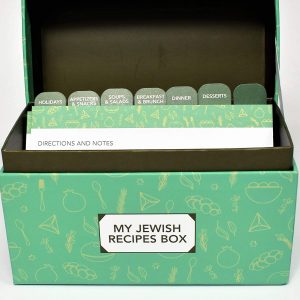My Jewish Recipe Box: Apple Fritters
Published June 30, 2021
This story originally appeared on JewishFoodSociety.com
Makes: 16
Total Time: 30 minutes
Ingredients
1 ½ cups all purpose flour
1 ½ cups water or milk
⅛ teaspoon kosher salt
3 tablespoons sugar
4 Granny Smith apples peeled, cored and sliced crosswise into ½ inch pieces
Peanut oil or sunflower oil for frying
3 teaspoons confectioner’s sugar for dusting
3 teaspoons cinnamon for dusting
ADVERTISEMENT
Preparation
1. Whisk the flour, water or milk, salt, and sugar in a mixing bowl until a smooth batter is formed.
2. Heat the oil in a medium pot or a deep fryer. When the oil reaches 350 degrees, dip 3 apple slices in the batter until coated well and place them in the oil, one by one, frying them until golden on both sides, about 3 minutes on each side. Transfer onto a paper lined baking sheet and continue frying the remaining apples in small batches.
3. Dust the fried apples with confectioners sugar and cinnamon and serve immediately.
The Back Story
“I grew up in Milan. We did not have any Jewish upbringing,” explains Lorenza Pintar, who now lives in Brooklyn. “It was my great grandparents that ended that.” They lived in Italy under Mussolini, who in late 1938 enacted the first of the Leggi Razziali, or Italy’s racial laws. Marriage between Italian Jews and non-Jews was outlawed, Jews were banned from educational institutions, and persecution was legalized in numerous other ways.
In order to protect themselves, Lorenza’s family ceased publicly practicing Judaism, but kept customs and traditions going in secret. On Fridays, Lorenza’s great grandmother Emma would polish candlesticks and move them close together, but not light candles. After Shabbat, she would separate the candlesticks. Her husband, Angelo, would lock himself in a room and pray alone. Lorenza’s mother Magdalen remembers hearing sounds through the walls as her grandfather prayed, unable to discern what he was saying.
Through the generations, traditions of secrecy were adopted and adapted in the family. Lorenza recalls her grandmother, Aurelia, lighting candles on Friday evenings, but not saying a blessing. Jewish foods, however, were a constant. “For us, it was all about food,” Lorenza explains. Special recipes would quietly appear on the family table at particular times.
ADVERTISEMENT
On Friday nights, Emma, who passed away right before Lorenza was born, would make fish in a spicy tomato sauce laced with paprika. She also made cholent, always with brown eggs sliced on top. And the family never cooked lunch on Saturdays, keeping the Jewish custom of not working on the Sabbath. Instead they ate rotisserie chicken or bread and cheese, Lorenza explains. And, pork was avoided. In the family, cassoeula, a Milanese cousin of French cassoulet, was made with goose instead of the traditional pork.

Lorenza’s grandmother Aurelia in Northern Italy in 1965.
As a child, Lorenza saw other children celebrating Christmas. “On Christmas Eve, I wanted to go to church…. To me, it was exciting,” she says. “My grandmother was like: ‘No, we don’t go.’” Instead, in the long evenings of winter, likely sometime near Hanukkah, latkes, tzimmes, Italian fritters called frittole, and fried apples appeared on her family table alongside stracchino, a local cheese that Lorenza describes as denser than sour cream, but with the same tang. It was served, “and then the dish would just disappear,” Lorenza explains.
When Lorenza’s sister passed away a decade ago, the family started to explore their roots more deeply at the suggestion of a therapist. As they researched, they found their family name in Sicilian records dating back to the Inquisition. They also have Ashkenazi roots from Poland. A colleague of Lorenza suggested the family create a cookbook of their Ashkenazi, Sephardi, and Italian recipes. Magdalena, who now also uses the name Yael, led the project with Lorenza translating the recipes for a small book called Rebelot, a Milanese slang word for something that’s all mixed up or chaotic, but leads to revolution.
“This whole process was very healing for my mom,” she says. From it, Lorenza adds, “I understood how important it is to be rooted.”

















